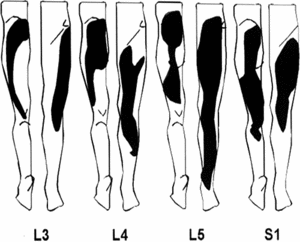New York's highest court of appeals has held that no-fault insurers cannot deny no-fault benefits where they unilaterally determine that a provider has committed misconduct based upon alleged fraudulent conduct. The Court held that this authority belongs solely to state regulators, specifically New York's Board of Regents, which oversees professional licensing and discipline. This follows a similar recent ruling in Florida reported in this publication.
Interspinous Ligaments May Relate to Chronic Low Back Pain
I wonder how many of you bother to palpate spinal interspinous ligaments? I still remember a lecture years ago by James Mennell, MD, whose textbooks on the science and art of joint manipulation are classics, during which he stated that if a ligament is tender upon palpation, there is something wrong with the ligament. Often through the years I have noticed that some patients with radiating pain extending from their lower back to the buttock and thigh suffer an exacerbation of the pain upon pressure on the C5-C6,C7-C8, L3-L4, L4-L5 interspinous tissue. (Figures 1, 2) Comparing the tender ligament to the one above or below often feels different regarding the density of the tissue. Sometimes, two adjacent ligaments are tender.
Tenderness of the supraspinous ligaments can occur anywhere along the spine. Often, friction massage of the referring ligament reduces or even eliminates the pain. According to Carla Stecco, MD, in her upcoming text, An Atlas of the Human Fascial System, "The superficial fascia adheres to the deep fascia along the spinous processes. In the thoracic region there are many septa never separated by more than 1 mm that insert into the supraspinous ligament. The lumbar region has five fan-shaped thick bundles that originate from the apex of the spinous processes."

There seems to be evidence that these interspinous ligaments are involved in both acute and chronic spinal pain. M.M. Panjabi theorized that a single trauma or cumulative microtrauma caused subfailure injuries of the ligaments and embedded mechanoreceptors.1 "The injured mechanoreceptors generate corrupted transducer signals, which lead to corrupted muscle response patterns produced by the neuromuscular control unit." This can result in muscle incoordination affecting individual muscle force characteristics such as "onset, magnitude, and shut-off."
This situation subjects the individual to abnormal stress and strain in the already aggravated ligaments, mechanoreceptors and muscles exerting increased strain on the facet joints. He states that since spinal ligaments do not have great healing ability, chronic back pain occurs due to eventual inflammation of the neural tissues.1
The corruption of mechanoreceptors is one of the chief hypotheses of fascial manipulation, which attributes the corruption to restricted motion of deep fascia over muscles. The spindle cells, which are located in the fascia, are unable to provide normal feedback to the central nervous system.
This whole concept of ligamentous sensory control changes our attitude about the function of ligaments in general. Ordinarily, we think of ligaments primarily as tissue that maintains the stability of joints. Solomonow, after 25 years of research, makes some (quoted below)2 interesting points about ligaments, affirming that ligaments are not passive structures since they exhibit creep, hysteresis and tension relaxation:
- "Ligaments are also major sensory organs, capable of monitoring relevant kinesthetic and proprioceptive data.
- Excitatory and inhibitory reflex arcs from sensory organs within the ligaments recruit/de-recruit the musculature to participate in maintaining joint stability as needed by the movement type performed.
- Long-term exposure of ligaments to static or cyclic loads / movements in a certain dose-duration paradigms consisting of high loads, long loading duration, high number of load repetitions, high frequency or rate of loading and short rest periods develops acute inflammatory responses which require long rest periods to resolve.
- Continued exposure of an inflamed ligament to static or cyclic load may result in a chronic inflammation and the associated chronic neuromuscular disorder known as cumulative trauma disorder."

So, applying tension to ligaments stimulates mechanoreceptors and a reflex arc that recruits muscular activity. All ligaments contain Golgi, Pacinian, Ruffini and free-nerve endings. Since it is necessary to rest ligaments, it becomes an argument for lumbar support after an acute injury.
In conclusion, it is important to palpate interspinous ligaments for tenderness and thickening, and attempt to reduce the thickening. It is important to palpate a thickening of restricted fibers before treatment. Some patients are normally hypersensitive and it is essential to rely on palpatory abnormality rather than patient tenderness. Sometimes 2-5 minutes is necessary to palpate a difference.
Often the patient's tenderness will be reduced and the range of motion will improve. The area may or may not require further treatment, but regardless, wait at least 4-5 days before repeating treatment. Again, palpation is more important than tenderness. It also pays to decrease the lumbar lordosis with an abdominal pillow to separate the spinouses.
There are many reasons why mechanical load has a positive effect on soft tissues, and substantial literature supports its use. I find that performing friction massage with my knuckle or using Graston instrumentation works extremely well.
References
- Panjabi MM. A hypothesis of chronic back pain: ligament subfailure injuries lead to muscle control dysfunction. Eur Spine J, 2006 May;15(5):668-76.
- Solomonow M. Sensory-motor control of ligaments and associated neuromuscular disorders. J Electromyography and Kinesiology, 2006;16:549-567.



